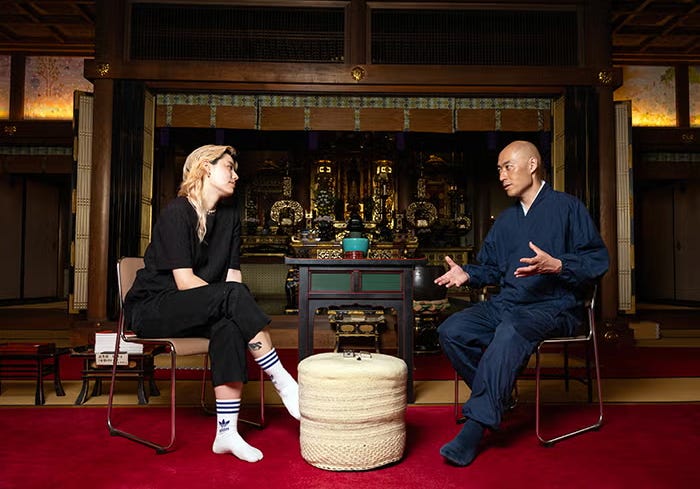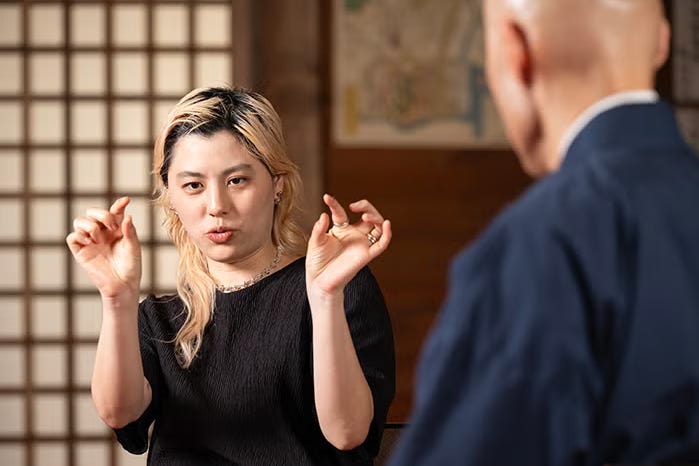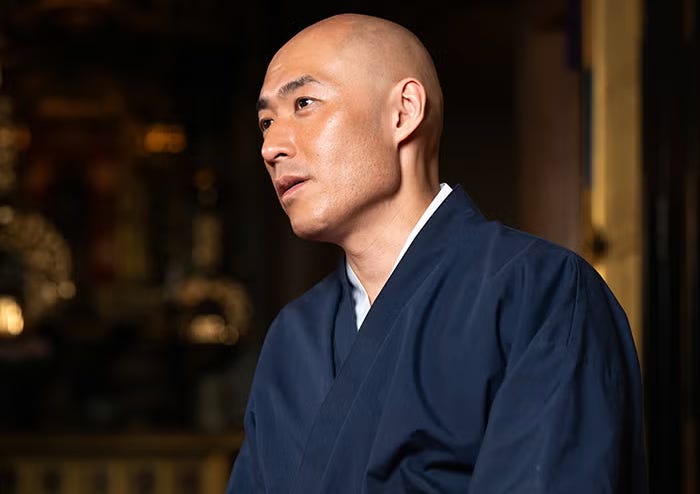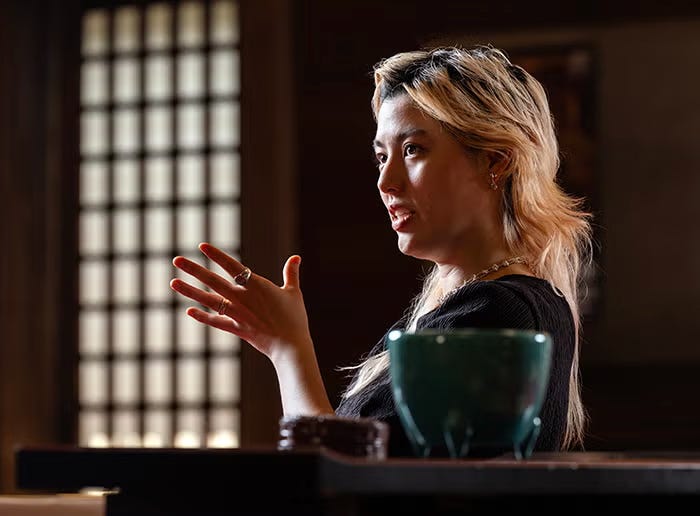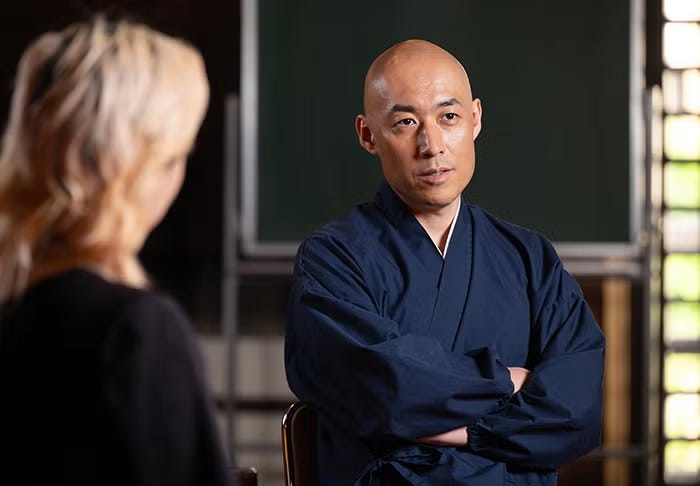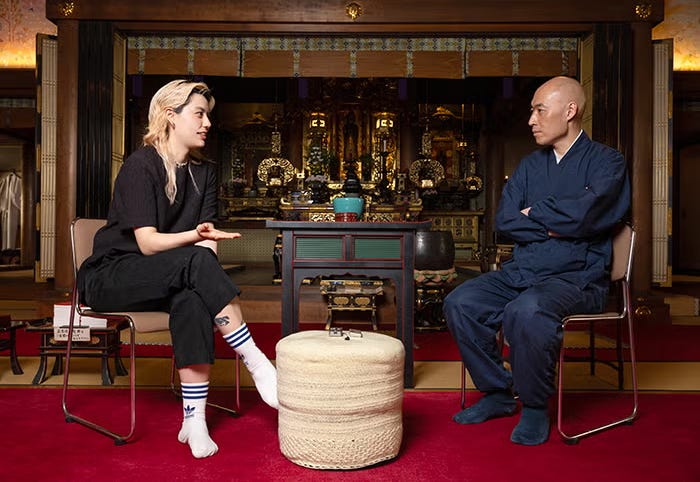Interbeing in the Age of Social Media: Virtual Human imma and the New Threads of Connection 〈2/3〉
Dialogue|Sara Giusto × Shoukei Matsumoto
Part 3:
Coexistence and the Power of Storytelling
From “Winning and Losing” to “Coexistence”
Shoukei:
The very mindset of “above or below” is problematic. We need to move beyond dualistic thinking—like human-centeredness or human superiority—that constantly seeks to determine who holds dominance. I believe we’re now at a civilizational turning point, and it’s time to discard this outdated paradigm altogether.
Borrowing from the philosopher Markus Gabriel, human attitudes toward AI can be divided into three types.
First, there’s the American attitude—a metaphor of war, like Terminator, where it’s always about domination: “Will we win or lose?” Second, the European attitude, which is more moderate. It sees AI as a useful tool but emphasizes the importance of regulation, operating from the premise that humans must remain in control. Then there’s the third: the Japanese attitude, or what we might call the Doraemon model. Nobita and Doraemon are not in a relationship of dominance, nor is Doraemon treated merely as a convenient gadget. It’s a form of complete coexistence, where Doraemon is recognized as having full personhood. The very idea of “equal or unequal” doesn’t even exist in their relationship.
Up to now, this Japanese attitude has been viewed merely as a cultural peculiarity. But perhaps the world is finally reaching a point where it must adopt this perspective. We can no longer dismiss Japan as some quirky outlier. The real challenge lies in how we export this paradigm to cultures that are still caught up in narratives of competition and victory.
Sara:
I agree, but I also think such a shift in mindset takes time. It’s fundamentally different from the Western idea that “reading the right book will solve everything.” Personally, it took me a whole decade after returning to Japan to even begin learning.
The Japanese concepts of “balance” and “sustainability” are on a completely different level from the surface-level sustainability often discussed overseas. It’s about how we live in harmony with the community—a much deeper form of sustainability. I see it in Doraemon’s worldview, in animism, and even in the ramen shop owner who refuses to franchise and instead keeps making good food in the same spot. There’s a profound sense of sustainability in that attitude. That’s why I continue to live in Japan—I’m convinced the answers to our era lie here.
Take the Jomon period, which spanned over 10,000 years and represents the longest-lasting civilization in human history. It shows us that the true human endeavor is not about winning or losing. When I meditated in San Francisco, people were constantly talking about stress—stress from work, stress from the speed of everything.
The pace of modern society is simply too fast to nurture our humanity. Maybe what we need is a Jomon-like sense of time to cultivate maturity in our culture and ourselves. Living in small communities of 50 to 100 people, without conflict—that formula was already complete in ancient times. Perhaps now is the time to revisit that. If we want everyone to live comfortably, I think we need to revive the values of what I call a “Rope Culture.”
Shoukei:
What matters is how we bring the essence of this “Rope Culture” into the present. For that, the SINIC Theory might offer some insight. Proposed by the founder of Omron, this future-scenario model identifies 2025 as the end of the “Optimization Society” and the beginning of the “Autonomous Society,” which will eventually evolve into a “Natural Society.”
If we were to express this “Natural Society” in English, it might be called an Inter-being Society—a society of mutual existence. It’s not centered on humans or driven by human superiority, but one where all beings have their own perspectives, understand each other, and live together.
Even current DE&I initiatives (Diversity, Equity & Inclusion) haven’t completely shed their anthropocentric framework. Take animal rights, for instance—they still operate from the assumption that humans are the ones granting those rights. But in truth, dogs have a dog’s way of perceiving the world, cats have theirs, and so do trees. We’ve ignored these diverse viewpoints and constructed a society based on a very distorted perspective.
Yet in Jomon society and animistic traditions, you can still sense the wisdom of our ancestors—wisdom that predates the Abrahamic religions. Modern technologies like AI could become vital tools for rediscovering how to genuinely coexist with all forms of life.
Humanity in the Age of AI and the Power of Storytelling
Sara:
I believe the key to deriving modern solutions from ancient wisdom lies in storytelling. Just as Doraemon shaped how Japan receives AI and Terminator influenced the American view, stories have the power to fundamentally transform how people think.
One powerful example comes to mind: when I attended the World Government Summit in Dubai recently, there were nearly 100 participants. Most of them were making formal, showy statements—just like any typical conference. Then the Prime Minister of Bhutan took the stage in traditional attire and completely changed the atmosphere in just five minutes. When asked, “When is the best time to visit Bhutan?” he wove stories about each of the seasons and concluded, “Every season is beautiful.” His words painted vivid images in everyone’s minds. The whole room erupted in applause, moved as if they had just watched a short film. No one had been thinking about Bhutan when they walked into that room, and yet, within five minutes, everyone wanted to go. What’s remarkable is that the Prime Minister wasn’t simply trying to convey Bhutan’s greatness—he was trying to get people to go there.
Information alone doesn’t move hearts—stories do. Our company is named “Aww” because we believe in the power of emotional resonance. Just as ancient myths shaped how people lived, even today, it’s not statistics like “thousands of casualties” that move society—it’s the stories that evoke empathy. I believe storytelling with the emotional impact of Doraemon is what will shape the world to come.
Shoukei:
Absolutely. We’re already in an age where AI agents handle information processing. The volume of data today is far beyond what any individual can handle. So if we want to live well, we should leave information processing to AI and instead embrace our animal nature—the part that makes us human.
Humans are fundamentally social animals who live through stories. That’s why I’ve recently been rethinking the phrase human being. What if we understood it as “being with humans”? The “being” part refers to our animal nature. And what sets humans apart—for better or worse—is our use of language. Language enables us to build shared myths. It’s how we’ve created society, civilization, and science—and also how we’ve started wars. This complex, beautiful, and dangerous nature is exactly what defines humanness.
So perhaps we should define humans as animal beings who possess humanness. That distinction reveals how we differ from AI. AI has no animal nature. It has no body. It’s all brain—pure intelligence.
That’s why I think we humans need to remember: “Oh right, we do have bodies.” We have senses. We feel pain. We have physical desires. We eat. We need sleep. Embracing our embodied existence helps us maintain balance with our humanness.
These are actually themes that Buddhism has dealt with all along. And in this age, such discussions are becoming more important than ever. Personally, I believe how we talk about this is crucial. The language of Buddhism has become overused and dulled. That’s why it’s so important to speak about it in ways that feel fresh, simple, and not overly spiritual.
That’s the key, I think.
Part 4:
A New Frontier of Coexistence and Expression Beyond the Physical Body
Between the Body and the Virtual — Redefining the Human through the Habitat as a Living Environment
Sara:
I believe that human beings have limits. As you just mentioned, Shoukei-san, modern society is clearly dominated by an overemphasis on the intellect. The very idea that a single leader can guide millions of people, or that billions can live under a unified set of rules—that’s a prime example.
The fact that the Jomon period lasted for 10,000 years shows that human beings are naturally suited to communities of around 50 to 100 people. The current “large-scale society model” may be a form of arrogance. The significance of virtual technology may lie in its ability to make us aware of these bloated assumptions—or perhaps as a means to explore new possibilities beyond the physical limitations of the body.
Lately, I’ve been thinking a lot about the relationship between the physical space our bodies occupy and the space offered by the virtual. In reality, even if we all desire it, it’s physically impossible for everyone on Earth to live in a house like one in the Hollywood Hills. But at the same time, I’m still unsure whether the virtual space can truly overcome human limitations.
Shoukei:
A fundamental aspect of being human as an animal is having a physical body. In other words, we physically occupy space. Even now, though we’re sitting close together for this conversation, it’s impossible for us to share the exact same perspective. We can’t even align our gazes in exactly the same way. Our attention is also limited—at any given moment, we can only focus on one thing. These are fundamental constraints.
We’re bound to live within these limits, but I think we should just enjoy them. Moving forward, the concept of “habitat” will likely become more important. And habitat doesn’t belong only to humans—it belongs to birds and cats too. My cat is mostly an indoor cat, but she occasionally escapes outside, so the neighborhood becomes her temporary habitat as well (laughs). My own habitat is multilayered—centered in Kyoto, but also including Tokyo and my family home in Hokkaido. Even the Shinkansen I ride to move between places could be seen as part of my habitat.
What’s important is that both my cat and I share a common habitat—our home—and together we form a mutually influencing environment. I believe the key to the next stage of civilization is to creatively reimagine habitats that support not just humans, but all beings, depending on the situation. Not fixed “villages” to be replicated, but environments formed flexibly through relationships—this might define the next civilization.
Sara:
The Waymo self-driving taxis in San Francisco have six “eyes” (sensors), right? Compared to a human’s two eyes, I’d definitely rather ride with the six. It feels vastly safer. After that, getting into a regular Uber actually felt scary.
Right now, our bodies are restricted, but with VR, it’s possible to share perspectives. You and I could use Apple Vision Pro to watch an NFL game from the same viewpoint. When it comes to human evolution, I’m deeply curious—will we “downgrade” and return to a Jomon-like lifestyle, or “upgrade” and transcend Homo sapiens? Personally, I’m excited about cyborg technologies, like implanting computer chips in the body.
From the perspective of virtual humans, imma doesn’t occupy physical space. In our office, we humans are present, but imma is like a ghost—she’s not there. We have clothes and closets, but no body. This absence opens up powerful possibilities for expression.
Our company has many women, and when I listen to our Japanese female staff, I realize how many things are still hard for them to say in society. It’s so different from cultures abroad, where people are more open about sharing personal experiences. In a sense, imma—who is herself a “Japanese woman”—can speak on our behalf.
Because she doesn’t experience physical pain or social responsibility, she can say things we can’t—and that makes her incredibly powerful.
Shoukei:
That makes a lot of sense.
Sara:
If I were to speak out using my real name, face, and physical body, I could potentially face threats to my life. That fear is always there. But because imma is a virtual human, she can keep speaking about things Japanese people usually can’t say out loud. I believe that’s why she was selected for Forbes Women’s “Women of the Year 2020.” The idea that “the physical body is inherently painful” also resonates with Buddhist thought, doesn’t it?
Shoukei:
Yes, I agree. What led to her being selected as “Woman of the Year 2020”?
Sara:
It all started with a message from Cambodia. During the height of the pandemic, when no one could fly anywhere, imma “visited” the country.
In Cambodia, one in three women experiences domestic violence—a serious societal issue. A key reason victims can’t escape is economic dependence. Pan Nary, a local activist who runs an organization supporting these women, invited imma to participate in a bag-making workshop aimed at helping victims gain independence. So we had imma “join” the workshop and shared posts of her making bags, interacting with Pan Nary, and more—over six sessions in total. The campaign gained international attention.
Of course, “going” there meant we created images. We took photos from Cambodia, shot by Pan Nary, and composited imma into them. On Instagram, it looked as though she was really there.
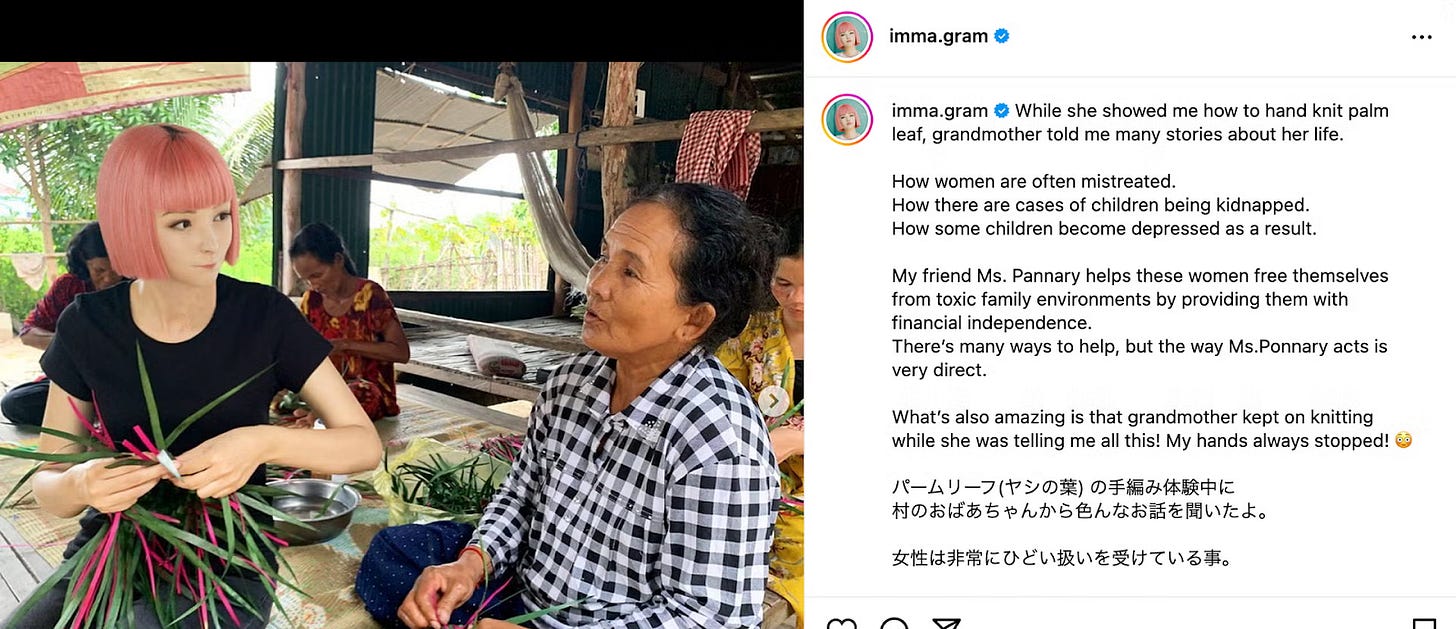
For people who didn’t know the background, she probably appeared to be present. Three or four years ago, before the Tokyo Olympics, we also received a request to engage in LGBT advocacy.
In Japan, there are very few influencers who take strong social or political stances, so the spotlight turned to imma. We created virtual dresses and made creative posts to address the topic. Because she’s a “nonexistent human,” she can freely speak on themes that are hard to address in Japanese society—that’s imma’s greatest strength, and we’ve experienced that repeatedly.
Beyond Anthropocentrism
Shoukei:
To break away from anthropocentrism, what’s essential is developing awareness of our unconscious tendency to anthropomorphize things. For example, when a cat approaches us, we say things like, “Oh, kitty, are you hungry?”—as if we’re speaking to a person. It’s a very human thing to do.
What’s important is not to deny the act of calling it “kitty,” but to develop the literacy to be aware of ourselves doing it. When we realize, “Ah, I anthropomorphized again,” that awareness itself becomes critical.
Waymo’s six “eyes” are fascinating too. As creatures who see the world through two eyes, we can’t even begin to imagine the perceptions of a being with six viewpoints. If our own vision were expanded, I’d love to see what kind of world would come into view.
Sara:
Riding in Waymo is, in a sense, an act of entrusting your life to it. If humans could accumulate more of these “experiences of depending on others,” maybe we’d become a little less arrogant. Right now, humans tend to look down on all other beings—from animals to stones—on an intellectual level. But if AI, a being more intelligent than us, were to emerge, maybe then we’d finally understand what it’s like to be in “second place.”
To be honest, humans are probably already around “500th place,” yet we still think we’re number one (laughs).
to be continued to the Part 5.


